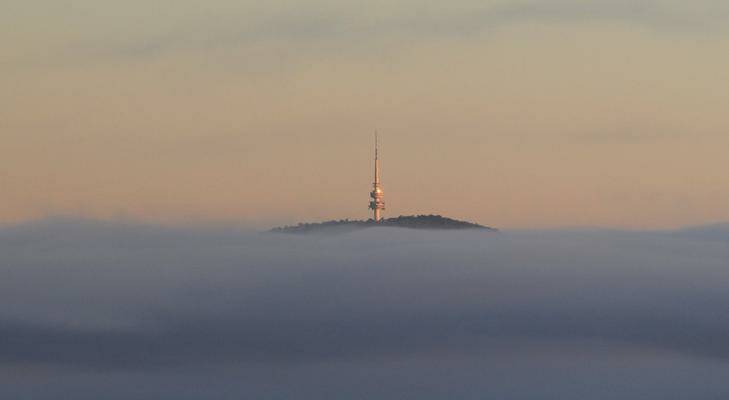The cold that numbed 25,000 of us at last week's Anzac Day dawn service was the very thing that has made this city possible in this sometimes Siberian spot.
Subscribe now for unlimited access.
or signup to continue reading
Those tens of thousands of Canberrans who will soon be shivering on wintry touchlines at their childrens' weekend sports, and every Canberran who is ever bitten by frost this winter can enjoy the same consolations.

Those influential men who between 1899 and 1908 searched for appropriate NSW places for a federal capital city only ever looked at places blessed with some ''bracing'' weather for some of the year. Nowhere hot, nowhere muggy got a look in. Every area that wanted the city promoted itself as just the kind of ''bracing'' location that was being sought. The Tumut District Improvement League, struggling to keep comparatively muggy Tumut in the race, pleaded that it was much cooler there than local temperature statistics seemed to suggest, because ''those official records given were taken by the primitive method of using an ordinary thermometer placed under an iron-roofed verandah, which would give a register of about 4 or 5 degrees above a correct test''.
Your snap-frozen columnist consoled himself with the vital importance of Canberra's coldness as, required to hurry back to the office to write quickly about the dawn service, I had to type with numbed fingers. From fingers feeling like frozen sausages some strange words were typed. The Tidbinbilla Mountains, from where I was trying to report the Anzac morning's icy winds had originated, became the tidbbeinlalala moontayaisns.
If Canberrans really are so much more intelligent, liberal, cultured and progressive (and modest) than all other Australians, why is this so? Can our ''bracing'' winters have anything to do with it?
When Robyn Archer, our creative director of the centenary shenanigans, confronts Canberra bashers she lectures them about Canberra's great achievements. One thing she points out to her victims is that Canberra generates more Nobel prize winners per head of population than any other Australian metropolis.
But how has all this happened? Mischievously, and only two-thirds seriously, your columnist suggests that what we are seeing now is a vindication of those who made sure that the federal capital city was built somewhere ''bracing''. NSW commissioner Alexander Oliver, who set the pace in these things from 1899, once defined a ''bracing'' NSW climate as one that reliably supplied ''many frosts'' in an average winter. Canberra is today the frost capital of Australia, with about 100 frosts a year. Hobart has about 30 but (inner) Melbourne only has about three and in an average year unacceptably muggy Sydney doesn't have any.
Oliver, like every thinking fellow of his times, shared the strong presumption that ''bracing'' cold-in-winter places were good for the physical and mental health. It was believed, too, that over time these places with some teeth-chattering weather bred a superior sub-species of our already quite superior Anglo-Saxon race. So can it be that, as generations of the wholly Canberra-born and Canberra-raised emerge, a superior kind of Australian, Homo canberraensis, is beginning to shine through? How else are we to explain our cleverness?
We would have been just as clever if the federal capital city had been built at Dalgety, as it very nearly was. Its bracing weather is almost identical to ours. ''We are told that the weather at Dalgety is cold,'' the pro-Dalgety Dr Malone lectured the House of Representatives in 1908 as a site decision loomed. ''But I remind honorable members that the stock from which we spring was a race emanating from the coldest countries in Europe … the Anglo-Saxon race. Did not the old Vikings come from the cold countries of northern Europe?''
Yes, perhaps Canberrans are, thanks to the ACT's sometimes Scandinavian cold, a new Australian race, a kind of Homo vikingoides.
People like Dr Malone and all of his influential contemporaries were marinated in these sorts of ideas. There was a whole field of science called anthropo-geography generating lots of authoritative-sounding books. The geographer and ethnographer Friedrich Ratzel (1844-1904) was one of the gods of this school and in her 1911 book Influences of Geographic Environment - On The Basis of Ratzel's System of Anthropo-Geography one of his disciples, Ellen Semple Churchill (1863-1932), wrote: ''In general a close correspondence obtains between climate and temperament.
''The northern peoples of Europe are energetic, provident, serious … [while] the southerners of the sub-tropical Mediterranean basin are easy-going, improvident, gay, emotional, imaginative, all qualities which among the negroes of the equatorial belt degenerate into grave racial faults.''
My sacred obligation as a writer to tell the truth about these things can cause some tensions. People who find out I know a little bit about Canberra's origins invite me to gibber about why Canberra is built where it is (so far inland, so elevated, so frosty, so inexplicably far from the balmy seaside) but then sulk when they're told the truth. They prefer the folkloric explanation they've always believed, that it was to put a federal capital city out of the reach of bombardment from the Russian navy. Crushing this fairy-tale belief, I feel like the first killjoy to tell a child that there is no Santa Claus.

